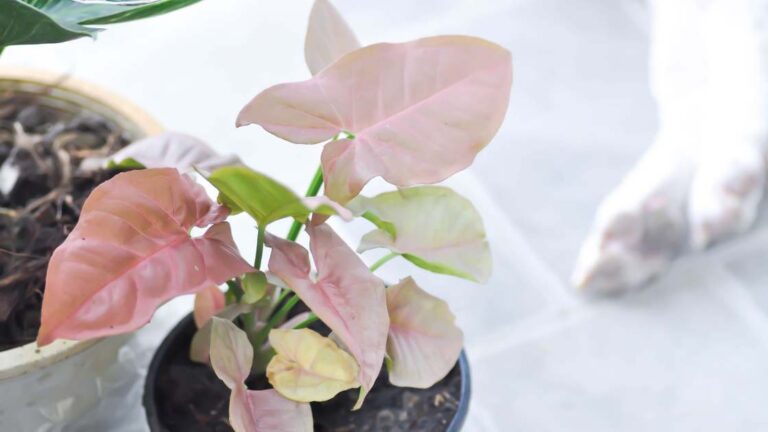Giant Chain Fern – All You Need To Know
If you have a giant chain fern and don’t know what you have to do in order to maintain this fern. Then don’t worry!
Giant chain ferns are usually sensitive ferns with a vulnerable chance of survival rate. Therefore, in this article, I will talk about a brief idea about these giant chain ferns and their characteristics.
Later on, I’ll try to give you some tips and suggestions so that you can maintain these plants.
Subsequently, I’ll also narrate the propagation method of this fern, so that you can propagate this fern at your house and hold their existence on the earth as well. So let’s delve into the topic more deeply.
Overview of Giant Chain fern

- Botanic name: Woodwardia fimbriata
- Common name: giant chain fern
- Family: Blechnaceae
- Plant type: perennial
- Native range: North America
- Light: partial sun, shaded place
- Soil: moist, well-drained
- Soil pH: acidic ( 5 to 7)
- Height: around 3 to 8 ft
- Width: almost 4 ft
- Special characteristics: container friendly
- Zone: 8,9,10
- Propagation: seed or division
Giant Chain ferns are one of the largest ferns in North American countries. However, Washington State identifies these Chain ferns as one of the rare species because it’s very sensitive.
Because of their sensitive characteristics, they become vulnerable in numbers as well.
These ferns mostly prefer woodland areas. In normal garden land, these ferns can grow up to 5 ft tall with soft green foliage. You also pair up these ferns with multi-shaded plants to increase your garden look.
These fronds can’t tolerate frost so you need to plant these under a protected and filtered shaded area.
Chain Ferns Care and Maintenance Tips
In order to maintain and care for these Chai ferns, you need to provide them with their ideal conditions such as light, soil, temperature, humidity, and so on.
Light
Giant Chain ferns prefer partial sun or full shade which means partial bright place or indirect sunlight. Mostly, these Giant Chain ferns also have less tolerance to direct sun exposure.
Thus, try to keep your ferns away from direct sun exposure or give them direct sunlight because excessive sun exposure can burn out their fronds.
You must give them ideal lighting for their ideal and active growth. That’s why you need to give them partial sunlight or filtered sunlight where they only get the brightness of the sun, not the direct sun rays.
You can also place them as houseplants under fully shaded places as well. And so, you can provide them with some artificial lighting which will promote their growth.
Soil
These Giant Chain ferns prefer acidic soil with pH levels 5 to 7. Similarly, try to choose well-drained soil which will drain out the excess water by absorbing and maintaining the hydration.
And so, you can use mulch which will hold the hydrated for your plants if the plants get too dry.
Water
Watering can be another essential part of every plant as well as for Giant Chain ferns. Routine and balanced water can make your plants thrive.
These giant chain ferns prefer moist soil, so you need to water them until the soil is hydrated. Try to avoid pouring too much water because they can’t tolerate standing water.
And so, Excessive water can have various problems such as rotten roots or fungus diseases. You can water them once a week in summertime.
But make sure the soil is dry when you pour the water. You can also check the soil by pressing it. On the other hand, under-watering can also make the plant’s soil dry and dehydrated.
In such cases, your plants might turn yellow and dull. So you need to balance your watering level to thrive the ferns.
Fertilizer
You can also mix organic compost, peat moss, and vermiculite in the soil to hold the richness of the soil. Additionally, nitrogen-based fertilizer is also the best option to provide nutrition to the plants.
Try to give your giant chain fern annual feeding which will hold the intensity of the soil.
Temperature
These giant chain ferns can handle up to 15 to 30° C in summertime. Even at that time, try to keep their temperature under 30° C because they can’t tolerate more than that.
Even in the winter time, they can’t tolerate below -10°C. You need to keep them between 0°C to survive your plants.
Pruning
Pruning is necessary to enhance the fern’s growth. If you observe any dead, dry, and deformed fronds, You just need those fronds with scissors.
Usually in their growing seasons, you can encounter these issues. So, in those seasons, you can prune to enhance your fern’s growth.

How to Propagate Giant Chain Ferns
Well, like all other ferns, you can propagate these ferns by root division and spore germination.
Spores germinate
Usually, fern’s spores lie down the fronds underneath. Thereby, you can choose any mature plants which have new spores on the underwear of the fronds and take a white sheet of paper in order to collect the spores.
Later on, you need to just tap, flick, or gently shake the fronds with your finger and let spores fall onto your paper. After collecting the paper from the fronds, try to take a small pot or container.
Then mix the soil with rich fertilizers such as ½ peat moss and ½ vermiculite. Later on, spread the spores on the soil. Then cover the pot or container with a plastic wrap to maintain the humidity and hydration.
You need to make sure the spores don’t get direct sunlight because it can burn the spores. Put them in a dark or shaded place for a couple of days.
Gradually, you will notice a green structure coming through from the soil surface of the ground. After noticing the first fronds try to water them consistently but don’t overflow or soak the soil.
After a few days, you can plant these in a new pot or container.
Root Division
You can also use another method for propagating your giant chain ferns. First, you need to select the correct season for propagation.
As their growth season is spring, you can do root division in late fall or early springtime.
For root division, at first, you need to dig up the whole plant from the pot or from the ground. Wear gloves if it’s necessary. Later on dust off the soil from the plants.
After that, you have to divide the roots from the main plants with a trowel or knife. Try to ensure each section has the same sort of roots.
Then replant each section into a pot or container or in your garden land. For your houseplants or indoor ferns, try to locate them in a partially shaded place after replanting the ferns.
- Discover More About Caring for and Growing Frosty Ferns.
Recap
On a recap note, these giant chain ferns are one of the rarest ferns on the earth declared by Washington state.
Therefore, growing and planting these ferns are not usually successful in surviving as they are very vulnerable and sensitive with a less survival rate.
However, you can still grow and care for these plants if you are a dedicated plant lover. By following those guidelines and steps you can provide them with healthy growth along with longevity.







